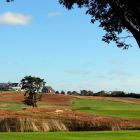Shinnecock Hills, one of the five charter clubs of the United States Golf Association (often known as the USGA or the @USGA depending on how mad you are at them on Twitter), has only hosted four U.S. Opens in its storied history. As of this writing, seven courses have hosted more. And yet there is a prevailing idea that Shinnecock might be the greatest venue of them all when it comes to Opens.
That is for more architecturally-inclined folks than me to decide, but I do know that Shinnecock Hills is a crown jewel of American courses and one of the toughest venues pros face all season. All of that (plus some unseasonably cool weather!) has me fired up to attend my fourth Open next week on Long Island as the world's best descend for the 118th playing of the United States Open.
Can’t remember the last time we had the U.S. Open played in high 60s-low 70 degree weather because that’s what it is looking like next week and I am just all in on this. Vest weather is the best weather.
— Shane Bacon (@shanebacon) June 6, 2018
Here are nine things you need to know about Shinnecock before players tee off on Thursday.
1. A brief history of an elite track: Accurate narratives from over a century ago are always tough, but from the research I've done, I've constructed a rough outline of how Shinnecock Hills Golf Club started. In the late 1800s, a group of New York men commissioned a pair of Scots -- both named Willie (Dunn and Davis) -- to design and build a course on some 80 acres they'd just purchased for $2,500.
There is confusion over who did what, but there is no confusion over the fact that a 12-hole course was hand-built (over Indian burial grounds!) at some point in the 1890s. After that, a nine-hole women's-only track was also built.
The 12-hole course was later redesigned to include 18 holes, reshaped in the early 1900s by Seth Raynor and C.B. MacDonald and then extended south where it was redesigned again in 1931 by William Flynn. It is, architecturally-speaking, exquisite. Here's Hamptons.com on how the construction originally went down.
Today, any construction project in Southampton comes to an immediate halt if Shinnecock graves or artifacts are found. There was no such sensitivity then: "The place was dotted with Indian burial mounds and we left some of these intact as bunkers in front of the greens," according to Davis. "We scraped out some of the mounds and made sand traps. It was here that the Indians buried their empty whiskey bottles, but we did not find this out until later when playing the course. One never knew when an explosion shot in a trap would bring out a couple of firewater flasks, or perhaps a bone or two."
After hosting the 1896 U.S. Open, the course sat dormant as a major championship venue for 90 years (although it did host the 1977 Walker Cup). Then it hosted three Opens in 18 years (with another planned for 2026) and underwent another makeover -- this one in 2012 by Bill Coore and Ben Crenshaw.
"I wouldn't call it a restoration," Coore told Golf Digest. "We made very minor alterations, not nearly on the order as what we did at Pinehurst, Maidstone and Old Town. We mainly polished, tried to ensure that alignments worked well from the tees. We did do significant work on the right side of the [par-4] sixth hole. It's at a low point, and the vegetation there had become prohibitively thick. We restored it to a more sandy character. But to be honest, I don't think we're even a footnote to the story there."
2. Those four Opens: Shinnecock has the distinction of the only course to host the Open in three different centuries. Its winners were as follows.
- 1896: James Foulis (152)
- 1986: Raymond Floyd (279)
- 1995: Corey Pavin (280
- 2004: Retief Goosen (276)
Willie Dunn, one of the original designers/builder actually co-led after the first round in 1896, but Foulis dropped a 74 on 'em in Round 2 (played on the same day) and won the second-ever Open by three.
3. Tiny first prize: Foulis' prize for winning that day, according to the New York Times, was $200. Even when you factor in inflation, that's only $6,000 in 2018 terms. The president of the club received a present from the USGA that was worth the same amount of money! Speaking of the Times, how good is this from the day after that second Open?
From the New York Times on July 19, 1896, which was the day after the first U.S. Open at Shinnecock (and second ever). I kinda see 2018 going differently. pic.twitter.com/SVWjpTCl5c
— Kyle Porter (@KylePorterCBS) June 7, 2018
4. Confusing winds: One of the more interesting parts of the way the course is structured is that, much like links courses in England and Scotland, it is often impossible to determine which way the wind is coming from and how it changes throughout your round. The reason for this is because holes criss-cross, and very few run parallel to one another.
One of the skills that made William Flynn a brilliant architect was his routings. Shinnecock shows this off, the course uses the ground well and each hole plays in different directions. This amplifies the effect that the wind has and adds to the challenge of the golf course. pic.twitter.com/dj8Y0rFmoJ
— the fried egg (@the_fried_egg) June 7, 2018
That helps create one of the toughest tests in the game (even before the USGA steps in). Speaking of the USGA, Phil Mickelson recently noted that he thinks they're going to get this one right!
"I think that this year's U.S. Open is the greatest setup going in that I have seen in my 25-whatever years of playing the U.S. Open," Mickelson said. "I think that it will reward the best player as opposed to having luck be a big element on some of the bounces in the fairway, bounces around the green, how it comes out of the rough. Skill is going to be the primary factor this week. It's just a, it's a tremendous setup that I've seen."
5. Width (and angles): One change that has been made since the last Open in 2004 is that the fairways were widened (kind of). They were narrow strips during the 2004 Open, but Coore and Crenshaw changed that in 2012. However, after last year's birdie festival at Erin Hills, the USGA narrowed them once again, although not nearly to the width they were in 2004. This will be the widest, most open Open played at Shinnecock of the five. Average fairway width in 2004: 26 yards. Average fairway width in 2018: 41 yards.
6. Bounce-back Open: Remember the 7th hole in 2004? The one the USGA lost and had to water during the final round while players were on the course? Yeah, CEO Mike Davis has acknowledged over the years just how egregious that was and why it won't happen again.
"It was certainly a bogey last time, maybe a double bogey," Davis said at a recent U.S. Open media day.
"Nowadays, we have got firmness meters, we've got moisture meters in the greens. The meteorology is better, so we know not only where the winds are coming from, but the velocities. And frankly, there's better communication between the USGA and grounds staff. So, I think we're comfortable."
I sure hope so.
7. An inclusive golf spot? Golf is, uh, not necessarily known for its progressive, inclusive nature, but Shinnecock might be a bright light on that front. For starters, they've had women members from the very beginning and even a women's-only course. They also supported John Shippen Jr. and his pal Oscar Bunn at the 1896 Open. Both men were Shinnecock Indians (although Shippen was half Indian and half black), and both helped construct the course by hand a few years earlier. When other entrants squawked about two Indians playing, the USGA pushed back in support of the Shinnecock club's support. The two played, and Shippen finished T5.
8. Oldest (and most dubious?) clubhouse: Shinnecock's classic clubhouse is apparently the oldest in the country, and it was designed by a man who (I cannot believe this is real) was murdered at the top of Madison Square Garden (which he also designed) by a man whose wife he had sexually assaulted. It turned into what was called the Trial of the Century. This was a real thing that happened!
9. First and last: Here's a lighter note to end things on. A flyover of the first and last holes at a course that should hold one of the better Opens we've seen in recent memory.

















